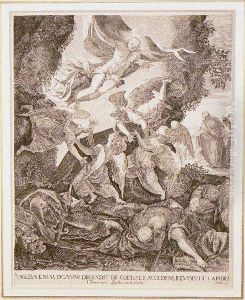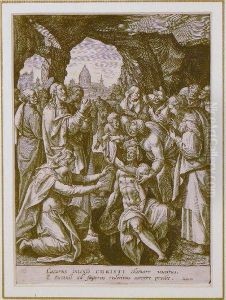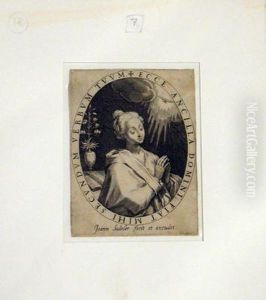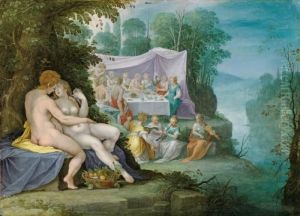Jan Sadeler Paintings
Jan Sadeler I was a renowned Flemish engraver, draftsman, and publisher born in Brussels in 1550, into a family of artists and printmakers. His brothers, Raphael and Aegidius Sadeler, were also prominent in the field. Jan was part of the Sadeler family, which played a significant role in the European printmaking world during the late 16th century. He received his early training from his father, who was likely a jeweler, and this background in intricate design would have influenced his meticulous engraving style.
Jan Sadeler's career began in Antwerp, a hub for the arts and a center of the publishing industry in the 16th century. He became a master in the Antwerp Guild of St. Luke in 1572. His work was marked by a high degree of skill and an ability to capture the essence of the original works of art that he often reproduced in print form. He collaborated with a number of well-known artists of his time, including Marten de Vos, whose works he frequently engraved.
In 1579, due to the turbulent religious and political climate in the Low Countries, Sadeler left Antwerp and moved to Cologne, and later to Munich, where he worked for the Duke of Bavaria. His relocation allowed him to work in a more stable environment and cater to different markets. He became court engraver to the Duke, a position that provided him with both patronage and protection. Jan Sadeler's engravings covered a variety of subjects, including religious themes, allegories, portraits, and landscapes, reflecting the broad range of interests and tastes of the European elite at the time.
Jan Sadeler's style was characterized by a combination of technical precision and a keen eye for detail. His prints were not only works of art but also served as a means for disseminating the styles and ideas of the Renaissance throughout Europe. Through his engravings, the works of Northern and Italian artists were made available to a wider audience, contributing to the spread of Renaissance art and ideas.
Jan Sadeler I died in Venice in 1600, where he had moved later in his life. His legacy was carried on by his son, Justus Sadeler, who was also an accomplished engraver. The Sadeler family's body of work remains an important resource for understanding the visual culture of the Renaissance and the role of prints in the art world of the time.



